History & Facts
History of Homosassa
Old Homosassa is an area rich in history. Its varied habitat and natural features, combined with a history of different cultures, has made Old Homosassa the unique community it is today. The first inhabitants were Native Americans. Archeological research indicates that Citrus County was occupied by pre-historic aboriginal people for 12,000 years prior to the arrival of Spanish explorers.
Although Hernando de Soto explored the area in the 16th century, it was the passage of the Armed Occupation Act of 1842 that spurred development. The act stated that a 200,000-acre area south of present-day Gainesville was open for settlement. This law stipulated that one hundred and sixty acres would be given to any head of family or single man over eighteen who was able to bear arms, could live on the land in a house fit for habitation during five consecutive years and cultivate at least five acres.
William Cooley took advantage of this opportunity offered by the Federal government. Cooley and his neighbors found the Act’s incentives appealing and submitted numerous applications to settle the land. As a landowner, merchant, pioneer, shipper of red cedar and the area’s first Justice of the Peace, Cooley played a prominent role in the settlement of Homosassa.
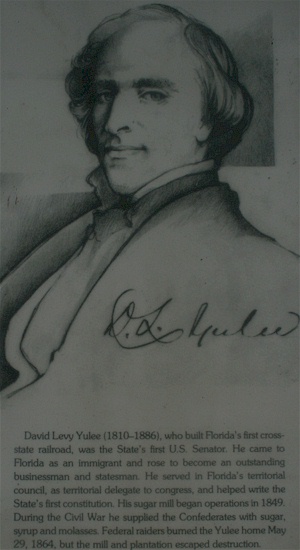 Cooley sold his land to David Levy Yulee and moved to Tampa in 1847. With the land purchased from William Cooley and the land that had been left to his father through a Spanish land grant, Yulee “established a 5,100-acre plantation and sugar mill in 1846.
Cooley sold his land to David Levy Yulee and moved to Tampa in 1847. With the land purchased from William Cooley and the land that had been left to his father through a Spanish land grant, Yulee “established a 5,100-acre plantation and sugar mill in 1846.
In the early 1840s David Levy Yulee, one of Florida’s first senators and developers, purchased thousands of acres on the Homosassa River. His slaves cleared over 1000 acres of land and planted sugar cane. He constructed a sugar mill and built a fine home on Tigertail Island, which became a port of call for the coastal steamers that linked the steamers on the Gulf to the world. A post office was established in 1845 and the 1850 Census reveals that settlers from many places and with varying skills were entering the area, taking advantage of land offered by the Armed Occupation Act.
Homosassa’s growth was interrupted by the Civil War. Interrupted is an appropriate word because only a few years after the war, there were many enterprises underway. “During the Civil War, Homosassa operated in support of the Confederate effort and was successful in stopping an attempted raid early in the war. In the end however, Homosassa was defeated and fell victim to the Union gunboats. Union soldiers destroyed the great sugar plantations, ending an era.
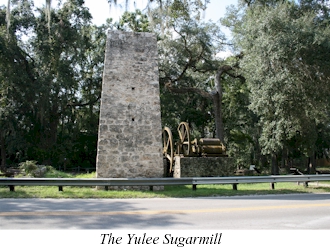
David Yulee felt first-hand the effects of the war. In May of 1864, a Union Naval attack destroyed Mr. Yulee’s mansion on Tigertail Island in the Homosassa River. The Sugar mill was not destroyed, but never put to use again.
Seeing the area as an opportunity for profit, three Northern investors created the Homosassa Company in 1884 to develop Old Homosassa’s land. John Dunn, Joshua Chamberlain, and Benjamin Dutton purchased thousands of acres of land once owned by Yulee with the intent on developing the area as a vacation spot for northern visitors, complete with railroad access and a resort hotel.
The Homosassa Company platted its acquired lands with full intentions of creating a city designed in the neo- classical tradition of combined diagonal streets and grid pattern. The 1886 plat pre-dated the “City Beautiful” planning movement, in which cities included public parks on the waterfront. However, the plat did express two of today’s community goals, pedestrian connectivity and public access to the waterfront, to greater extent than exists today. The platted public plaza, a pedestrian amenity, was replaced by a fire station, a danger to pedestrian activity. The platted lake access to the river was never constructed and is now the elementary school.
Although the 1886 plat was never completely constructed and has been compromised by repeated street
vacations and lot reconfigurations, its original design intent is a historical legacy that is in part visible today. In 1985 a prescriptive plat was recorded based on a survey of the area and the original town plat.
In 1887-1888, the Silver Springs, Ocala, and Gulf Railroad Company constructed from Dunnellon to Homosassa an extension of its Ocala to Dunnellon line, which was built in 1885-1887. The train opened up trade and tourism between Homosassa and Ocala, and from Ocala to the northeast and the rest of the country. The railroad facilities in Homosassa consisted of the depot, a freight dock and storage shed, a siding for cars to be loaded and a turntable for turning the locomotive around. In November 1941, the track and depot in Homosassa were retired and the nostalgic days of railroading came to an end.
A familiar pattern was beginning to evolve, one that is still being used by land developers. Advertising and a well-designed sales campaign drew prospective buyers who came as tourists, staying at hotels built by the land company. Well-connected investors and visitors to the area such as Grover Cleveland, John Stetson, John Jacob Astor, and Henry Plant added prestige.
The West Coast Development Company tried again in the 1920s to take advantage of the public’s fascination with Florida land. Like the Homosassa Company, they purchased thousands of acres, advertised heavily, brought in celebrities to attract prospects, and began ambitious building projects.
The Great Depression brought notions of powerful development to a halt in the 1930’s. The only legacy that remained was Dunn’s Homosassa Inn “which was visited by such notables John Jacob Astor, Winslow Homer, and Thomas Edison.” (Homan & Reilly). Now owned by the MacRae family as a private residence, the Homosassa Inn still stands as a beautiful landmark for Homosassa.
Although the construction of U.S. 19 in the 1940s provided an easier access for motoring tourists, it wasn’t until the 1960s that another development company was influential in Old Homosassa. The Norris Development Company, led by Bruce Norris of New York demolished the original Riverside Lodge built by B.F. Dutton and created a resort with such amenities as a boat ramp, pool, and a 74-room hotel. This time, Homosassa was widely recognized as a recreation, resort, and retirement center. Moreover, Homosassa’s transition from water-dependent (fishing) to a water-enhanced (tourism) economy was clear.
The latter half of the twentieth century brought with it an increase in infrastructure for Old Homosassa. The roads were paved from US 19 into the heart of Old Homosassa soon after the Norris Development Company had built the Riverside Resort. Along with increased tourism came permanent residents and the necessary infrastructure; water lines were laid and became available in 1957, and a fire station, library, new elementary school, and new post office were all built in the years that followed.
David Yulee’s sugar cultivation was not the only natural resource in Homosassa that provided an economic market. The lumber and citrus industries were both integral to Homosassa’s growth and notoriety. Cedar mills processed the lumber from the trees which had once covered all of the coastal islands until there were few trees left and the sawdust was used for fill in the swampy shores so that more land could be developed. Second forest growth has covered the evidence of these industries and there has been no agricultural redevelopment.
The natural resource that has had the most impact on Homosassa’s economy is the fishing industry, both commercial fishing and sports fishing. The numerous species found throughout the Homosassa River and Gulf of Mexico have provided a subsistence and profitable way of life for generations of Homosassa residents, as well as recreation for tourists. From the time of the Indians to the time of the “Mullet Express,” the seafood industry was a staple and integral part of Homosassa’s culture. Unfortunately, most of the commercial fishing industry has succumbed to the combined pressures of decreasing catches, pollution, net bans, environmental regulations, and the high cost of fuel and fleet maintenance.
Today, Old Homosassa still has a sense of place as a “fishing community” which coexists with an ever-growing tourism industry. Until now, development of the community has been slow and largely in keeping with the community’s image of itself.
The Community
Seventy percent of Homosassa’s citizens are aged 45 or over, contributing to a median age of 58. Considering that the median age for Citrus County is 53 and that the median age for Florida is 39, it is clear that Homosassa is an “older” community. Age is the most important dimension of population in that it relates to service needs. The older composition of Old Homosassa is one reason for the goals of pedestrian connectivity and local community facilities being identified in “visioning” meetings.
Homosassa’s recent population growth rate is smaller than that of Citrus County and Florida. This smaller growth rate is largely responsible for the retention of Old Homosassa’s character. It is anticipated that the future sewer lines, projected to be installed by 2004, and the nearby availability of the Suncoast Parkway will bring increased population growth to the area.
Old Homosassa has numerous businesses and organizations, all of which contribute to the character and success of the community. The following is a description of the major businesses, historic structures, organizations, government entities, and public facilities…
Resorts
The tourism and sports fishing industries have led to the development and redevelopment of two notable resorts. These resorts have been maintained in private ownership, somewhat restricting public access to the Homosassa River while at the same time maintaining high aesthetic standards for tourists and local customers.
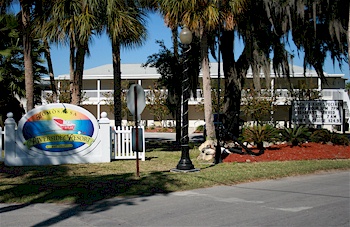 Homosassa Riverside Resort
Homosassa Riverside Resort
Initially built as a “bed-and-breakfast” inn in the late nineteenth century by B. F. Dutton, this location has been a destination for visitors since it’s inception.
Today, the Riverside Resort is a 74-bed resort catering to both tourists and the community. Included within the resort are a restaurant, private boat ramp, marina, dive shop, conference room, and various guide services.
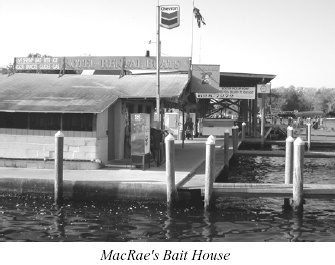 MacRae’s of Homosassa
MacRae’s of Homosassa
Established by Scottish immigrants Mary Isabell and James Alexander MacRae in the early twentieth century, J. A. MacRae’s General Store was the first of many MacRae family business endeavors.
Currently, MacRae’s maintains a bait-house, a 23-room motel, boat rentals, tiki bar, gift shop and various charter services.
Historic Residences
The history of Old Homosassa is visible today in these structures. One of the community’s goals is to preserve this historic character.
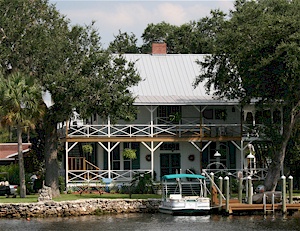 MacRae’s House
MacRae’s House
Built by land agent and developer John Dunn in 1882, the Homosassa Inn was a sportsmen’s lodge. James and Mary MacRae purchased the structure in 1919 with the provision that the previous owner, Helen Richardson, be permitted to live there until her death. In 1932, the MacRae family reopened the house as a lodge and later a restaurant. By the mid-1990’s family members had once again converted the Homosassa Inn to a private home.
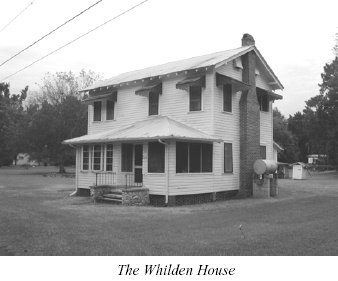 Elta Whilden’s House
Elta Whilden’s House
Constructed in 1926, the Whilden house is still occupied by one of its original residents. As Old Homosassa’s oldest resident, Ms. Elta Whilden is still able to provide a colorful history. Her husband Wade constructed their house standing adjacent to what was the train turntable. As the train conductor, Wade was able to attend to his duties in a moment’s notice.
Fishing Businesses
Commercial fishing is in decline in Old Homossassa, leading to the possibility that these properties could face redevelopment to some other use if not protected and encouraged.
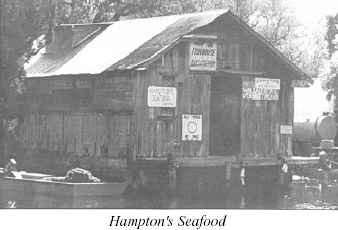 Hampton’s Seafood
Hampton’s Seafood
The Hampton’s Fish House was built in the 1920’s by Luther and Doc McReynolds. It was soon sold to T. L. Rogers who then passed the business to his sons, Buddy and Dick Loclar. The Locklears’ family still owns the fish house and currently leases it to an independent fishing family.
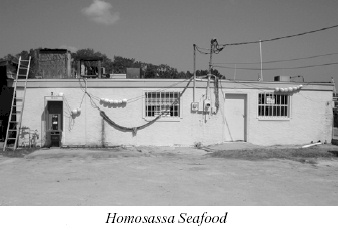 Homosassa Seafood
Homosassa Seafood
Since the 1920’s. a fish house has occupied the property where Homosassa Seafood stands today. Currently, the company maintains a large shrimping and crab fleet, selling wholesale.
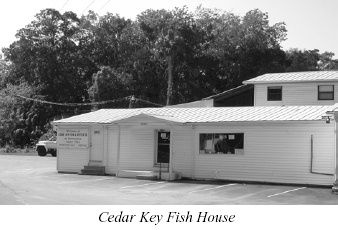 Cedar Key Fish House
Cedar Key Fish House
Established in 1962 by Buck Sheppard and family, the Cedar Key Fish House has the reputation for introducing mullet and mullet roe to the world. Shrimp, stone crabs, oysters, scallops, and other fish are sold retail and wholesale. The family currently leases the fish house to another seafood company, Shrimps Landing.
Community Facilities
Old Homosassa is fortunate to have a number of community facilities. One of the community’s goals is to preserve these facilities as part of Old Homosassa’s character.
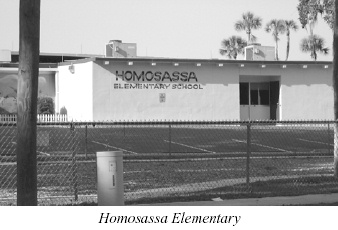 Homosassa Elementary School
Homosassa Elementary School
Homosassa Elementary educates approximately 400 students in grades Kinderparten through 5th grade. Although the existing school was constructed in 1971, it is not the first Homosassa Elementary. Three schools are known to have existed in Old Homosassa prior to this one, the first one dating from 1882 on Gordy Island.
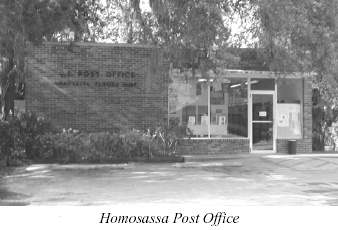 Post Office
Post Office
The first Post Office was constructed on the north side of the river in 1880 and moved to the south side in 1913. Prior to the current location, a post office made of cabbage logs was constructed in 1948. Today’s post office was constructed in 1968.
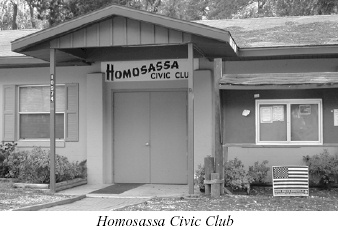 Homosassa Civic Club
Homosassa Civic Club
Founded in 1950, the Homosassa Civic Club constructed its clubhouse in 1957. Today, the clubhouse serves as headquarters for the club as well as a meeting place for community organizations.
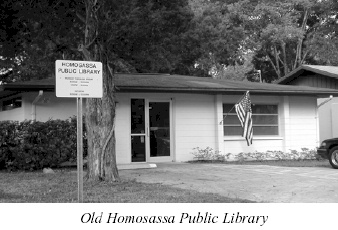 Old Homosassa Library
Old Homosassa Library
Constructed in the late 1960’s on property donated by the Homosassa Civic Club, the quaintness of Homosassa’s public library is in keeping with the character of the town.
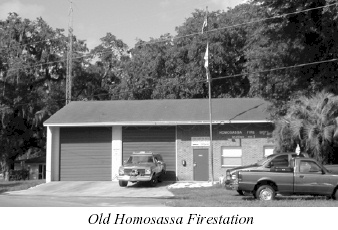 Old Homosassa Fire Department
Old Homosassa Fire Department
The Homosassa Volunteer Fire Department occupies a building constructed in 1964 and continues to provide services for the community.
Public Recreation
Two public recreation areas exist in Old Homosassa today, a State of Florida park and a Citrus County Boat Ramp. A future park is planned by the Civic Club in the Waterfront District.
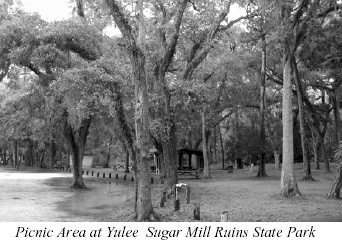 Yulee Sugar Mill Ruins State Historic Site
Yulee Sugar Mill Ruins State Historic Site
The Yulee sugar Mill Ruins were managed by the Citrus county Federation of Women’s Club until they donated the land to the Florida Board of Parks and Historic Memorials on June 24, 1953. Today, this 4.49-acre site encompasses the Sugarmill ruins and a picnic area and is maintained by the Florida Division of Recreation and Parks.
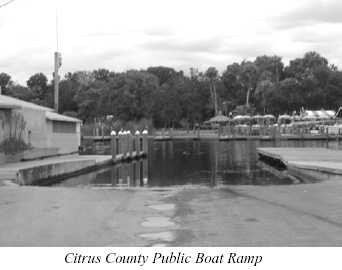 County Boat Ramp
County Boat Ramp
Centered between MacRae’s and the Riverside Resort is the County boat ramp. The established date of the boat ramp is unknown, but according to local historians “there has always been a public boat ramp.” The County has recently constructed a parking facility for users of this boat ramp.
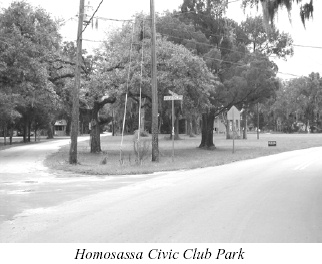 Homosassa Civic Club Park
Homosassa Civic Club Park
The Homosassa Civic Club Park is currently used for the annual Fish and Arts and Crafts estival and related parking.
Infrastructure
Water
Homosassa citizens receive public water service from the Homosassa Special Water District. The District serves a population of 4,567, including the Old Homosassa community. Pollution of private wells from septic systems is not an issue as long as residential properties are connected to this water system.
Sewer
There is no public sewer system. Most properties are served by private septic systems and, in some cases, environmentally unsound systems. A plan has been adopted to provide a central sewer line to the area. This plan is funded by Federal, State, and County monies. This endeavor is seen by some citizens as a “double-edged sword”, beneficial to the environment and water quality but encouraging more extensive development. Although a public sewer system is available on the north side of the Homosassa River, not all properties along this line are connected.
Stormwater Management
The lack of a stormwater management system in Old Homosassa causes local flooding and untreated water entering the river. In order to implement Policy 3.1.9, of the Citrus County Comprehensive Plan, regarding flooding in adjacent areas and pollution of water bodies, enhanced development standards are recommended. These enhanced development standards should address stricter fill limitations as is common in other waterfront communities.
Major Roadways
The Suncoast Parkway from Tampa to US Hwy 98 has recently been completed, providing improved access to Tampa from the southern part of Citrus County. By connecting Old Homosassa to businesses in Tampa and the Tampa International Airport, this toll road is a major encouragement to development in the area. West Yulee Drive (CR-490) provides one of the community’s connections to US Hwy 19. The Citrus County Comprehensive Plan recommends upgrading a portion of this road to a four-lane divided highway.
Sidewalks
A sidewalk exists intermittently on the northern side of West Yulee Drive. It extends from the elementary school to near the Sugarmill State Park and is interrupted by several parking lots. Pedestrian connectivity is an important goal of the community and should be addressed by public and private development plans.
Envorinmental
All of the Homosassa lies in an environmentally sensitive coastal area. Moreover, most of area’s growth has been adjacent to the rivers, creeks, and wetlands. Goals, Objectives, and Policies for protecting this environment are included in the Citrus County Comprehensive Plan.
Water Quality
The quality of Homosassa’s water is paramount in retaining the natural habitats and aesthetic value that have long been associated with this community. Land use affects surface water in two ways: first, by increasing surface runoff, which increases flooding and stream degradation in down-stream areas; and second, by contributing pollutants such as oils, sediments, and heavy metals to stormwater runoff. Citizens need education about point pollution, such as septic systems, and non-point pollution, such as nitrates from fertilizers and stormwater runoff.
Wetlands
Protection of Homosassa’s wetlands has been a top issue for many of the town’s residents who believe that potential developments could disrupt or eliminate wetlands. Enhanced development standards and levels of public review are needed for these environmentally sensitive areas. The protection of natural wetland systems is necessary to maintain habitat for flora and fauna as well as to maintain water quality for future generations.
Manatees
The West Indian Manatee is a year-round inhabitant of the Homosassa River and draws tourists from all over the world. The Homosassa Springs State Wildlife Park is located in close proximity to Old Homosassa. It has the second highest traffic of any of the Florida State parks.
Flood Plain
Most of Homosassa lies in a Federal Emergency Management Agency (FEMA) flood Zone. This is the flood insurance rate zone that corresponds to the 100-year floodplains that are determined in the Flood Insurance Study (FIS) by approximate methods.
On August 15, 1984, Homosassa was entered in the National Flood Program, leading to building restrictions. After 1984, with a Base Flood Elevation of nine feet for most of Homosassa (as defined by FEMA) new construction and substantial improvement must be four to five feet above natural grade.
These regulations create a challenge when attempting to achieve architectural styles consistent with the historic character of Old Homosassa. Development standards and public review process for development in the flood plain must balance citizen lifestyles and the historic character against environmental degradation in the following ways:
-The historic character of Old Homosassa is defined by unobtrusive structures constructed on grade prior to the flood regulations, but FEMA regulations do not allow variances for living spaces below the base flood elevation.
-The Florida Accessibility Code (Florida Building Code) requires handicapped access in public places and older citizens require easy access in residences, but elevators limit development to large expensive structures.
-Practicality and aesthetics lead to a preference for non-elevated structures, but fill to achieve required grades is problematic due to the lack of stormwater management and related local flooding and river pollution.
Outstanding Florida Water
The Homosassa River was designated an “Outstanding Florida Water” by the Florida Legislature in 1992. An Outstanding Florida Water, (OFW), is a water designated worthy of special protection because of its natural attributes (FDEP website).
Trees/Native Vegetation
The trees of Homosassa are a special component of what makes the town beautiful. Saving specimen trees as well as specific tree canopies are essential in maintaining the quaint character in Homosassa.
Besides offering a pleasing aesthetic value, trees offer the benefits of shade for cooling effects and can serve as a noise and visual buffer for non-compatible land uses.
(from APPENDIX H Old Homosassa Community Redevelopment Area Plan, The Board of County Commissioners for Citrus County, November 18, 2003)
DEVELOPMENT/REDEVELOPMENT ISSUES
Most of the development in Homosassa during the past decade has been re-development.
Some long-standing structures have been renovated. The Homosassa Riverside Resort, the largest private property within the Waterfront District, has been restored and improved, as has MacRae’s of Homosassa, another waterfront property.
The owners of Lawson’s Seafood have refurbished the historic Old Hampton Seafood House after it was damaged in the 1993 winter storm. Citrus County has constructed a parking facility for users of the public boat ramp and dock in Old Homosassa. In addition, the Homosassa Civic Club recently purchased land within the Waterfront District and has begun preparation to create a community park.
As increased development becomes possible in Old Homosassa, the community must deal with retaining its character. Sustainable development is an overall goal that could encompass community issues. Sustainable development is “development that meets the needs of the present generation without compromising the ability of future generations to meet their own needs.” (World Commission on Environment and Development 8) If Old Homosassa is to be a sustainable community, the following three issues are paramount:
Environmental Protection: Environmental viability, including flood considerations, should not be compromised by economic development. Compact development, encouraged by the original 1886 Town Plat, would help to conserve environmentally sensitive lands.
Economic Development: New residents and tourists are needed, to some degree, to provide economic health in Old Homosassa, but this presence should be encouraged in a way that promotes environmental protection and a sense of place for the community.
Social Equity: Participation of affected stake holders should continue as was done in the Waterfronts Florida visioning process. Future residential development should not preclude existing residents from continuing to live and work in Old Homosassa.

